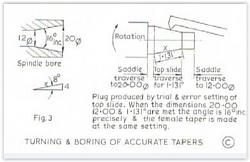One of the many useful operations possible with a lathe is to cut tapers. These can be external or internal. Sometimes an external taper is cut and I want a matching internal taper. This article presents a procedure that requires no math or measuring to set up to cut the internal taper.
If you are interested, please see
https://rick.sparber.org/MatchingTapers.pdf
Your comments are welcome. All of us are smarter than any one of us.
Thanks,
Rick



 LinkBack URL
LinkBack URL About LinkBacks
About LinkBacks


 Reply With Quote
Reply With Quote



Bookmarks